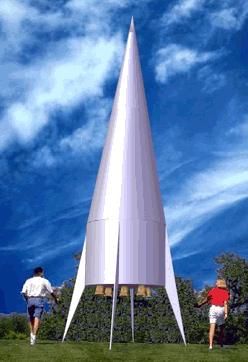
Home - Search - Browse - Alphabetic Index: 0- 1- 2- 3- 4- 5- 6- 7- 8- 9
A- B- C- D- E- F- G- H- I- J- K- L- M- N- O- P- Q- R- S- T- U- V- W- X- Y- Z
Lucky Seven
 Lucky Seven |
Status: Study 2004. Height: 9.00 m (29.50 ft). Span: 3.00 m (9.80 ft).
Lucky Seven was a design of Mickey Badgero of Acceleration Engineering, Bath, Michigan. The concept used rocket-powered vertical takeoff launch and parafoil landing. Lucky Seven was to be a conical rocket 9 meters long and 3 meters between fin tips. For launch and landing, the rocket was to be supported on four fixed leg-fins, each 1.5 m tall. These legs were part of a metal frame that supported the propulsion system, a pressurized cabin, and a nose cone/recovery system. Launching vertically, the main engine, a pressure-fed, liquid oxygen/liquid methane design , was to burn for 90 seconds, after which the rocket was to coast for another 100 seconds past the 100-kilometre altitude mark. Passengers were to experience weightlessness for about three and a half minutes. Upon re-entering the atmosphere, a drogue parachute was to be deployed to slow the ascent. When the air thickened, a parafoil was to be deployed. The spacecraft was to then return to the launch site, using a Global Positioning System satellite guidance system, gliding to a vertical landing.
Family: America's Space Prize, Manned spacecraft, Suborbital. Country: USA. Agency: Acceleration.
Back to top of page
Home - Search - Browse - Alphabetic Index: 0- 1- 2- 3- 4- 5- 6- 7- 8- 9
A- B- C- D- E- F- G- H- I- J- K- L- M- N- O- P- Q- R- S- T- U- V- W- X- Y- Z
© 1997-2019 Mark Wade - Contact
© / Conditions for Use